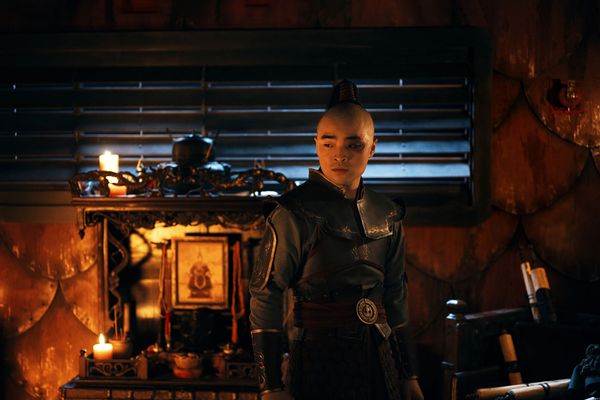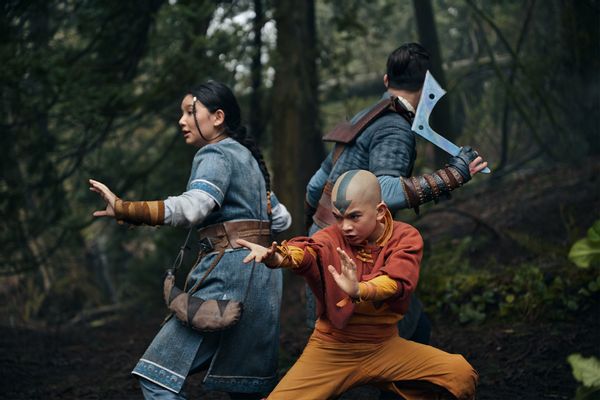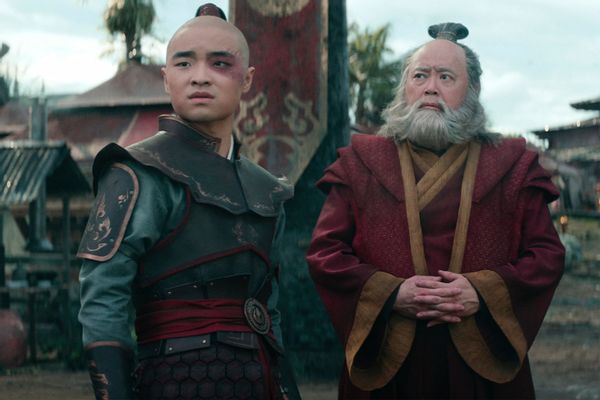
Clenching is a respectable response to any announced adaptation of a beloved animated property, especially when Netflix is producing it. The company and fantasy have mixed uneasily over the years, with successes being rarer than outright failures. That’s doubly the case with anime and anime-influenced works like “Avatar: The Last Airbender,” a Nickelodeon title that has earned a passionate, multigenerational fanbase.
In 2018 Netflix dangled the promise of a live-action do-over with the original series' creators Michael Dante DiMartino and Bryan Konietzko taking the reins. But that didn’t last. Two years later DiMartino confirmed in an open letter posted on his blog, which has since been deleted, that he and Konietzko had parted ways with the production.
“Netflix’s live-action adaptation of 'Avatar' has the potential to be good,” DiMartino wrote. “It might turn out to be a show many of you end up enjoying. But what I can be certain about is that whatever version ends up on-screen, it will not be what Bryan and I had envisioned or intended to make.”
Maybe DiMartino and Konietzko’s absence won’t matter to a fair share of the audience, many of whom might be experiencing this story for the first time. There are still plenty of animation-averse viewers out there. So we should be grateful this is a superior gateway to M. Night Shyamalan’s 2010 feature-length insult, which maintains its status as one of the worst films ever inflicted on the public.
Take heart in knowing this adaptation of “Avatar: The Last Airbender” is far better than that one. One can even comfortably call it passable.
If it earns the audience’s patience, that’s due in no small part to Gordon Cormier’s convincing embodiment of Aang, the eponymous 12-year-old boy burdened with guarding the world’s elemental balance.
The Avatar is the one person in a world split between four nations – Water, Earth, Fire and Air – who can manipulate all the elements along with his natural-born talent. Aang, an Air Nomad, is a born airbender. But before he can ship off to learn from other masters, a storm overwhelms him, leading him to be trapped in ice for a century.

“Avatar: The Last Airbender” first premiered in 2005, not long after Peter Jackson’s film adaptations of J.R.R. Tolkien had established what fantasy filmmaking and storytelling can and should look like. Nearly every modern fantasy epic is based on some version of Tolkien’s narrative architecture, including this one – which also ran on TV in the same era as the Harry Potter movies. (Aang, like Harry, is another Chosen One.)
Similarly, nearly every film or TV adaptation of a story based on an elaborately constructed world is at some point held up to the standard Jackson established. Tolkien experts pointed out the ways the movie diverged from the novels, primarily casting these choices in a respectful light. He maintained the soul of the literature while satisfying the storytelling economy a feature demands.
Showrunner Albert Kim takes a few gambles in this respect. The original built to a massive battle that ended its first season. Kim’s adaptation opens with a pivotal tragedy only implied in the source material that may spark debates about screen violence, especially in a story centered on child heroes.
The counterpoint is that “Avatar: The Last Airbender,” for all its gentle lessons and optimism, is a story about a genocide survivor desperately striving to prevent other cultures from being wiped out. When I wrote about the animated series’ resurgence in 2020, I expressed the hope that the world would be in a better place when this adaptation premiered. Given how sheltered Americans have been kept from the realities of genocide occurring right now, watching a small screen depiction of a fictional one up close may serve to remind people of the human suffering behind those bloodless reports.
Nevertheless, one can’t get past a stagnating feeling that these eight episodes are merely sufficient, locking down enough key particulars to justify keeping it alive to see the next “book” while fulfilling acts of fan service.
Cabbage Man stans, you’ll be pleased to know James Sie, who originally voiced the produce vendor, shows up here. Sie’s presence is one of many affectionate tributes Kim and fellow producers include throughout the series, some subtler than others.
“The Lord of the Rings” comparison is necessary due to what those blockbusters inspired. We wouldn’t have “Game of Thrones” or “The Witcher” if people didn’t lose their minds over Frodo and his crew at the top of the Aughts. More recently, Prime Video wouldn’t have spent an astronomically obscene amount of money to bring to life "The Lord of the Rings: The Rings of Power."
Amazon’s gargantuan fantasy entry may be the most pertinent citation in this argument since a visual comparison between it and “Avatar: The Last Airbender” places Aang and company on the losing side. The depth of thought and planning that went into the practical aspects of the production are visible, especially in the Wushu-heavy fight choreography and other action sequences. But the amount of CGI buoying this production is noticeable to distraction.

Then again, Midthunder playing Princess Yue in a cast primarily comprised of Indigenous and Asian actors should be viewed as a win. These choices speak to the producers’ determination to correct Shyamalan’s sloppiest error: casting white people as the heroes, most of whom couldn’t act their way out of an unfenced yard.
I may not have been blown away by Kiawentiio’s portrayal of Katara but at least she’s not a white girl being passed off as Inuit-adjacent. (Shed no tears for Nicola Peltz, people – she’s an heiress who married into the Beckham family. She’s fine!)
DiMartino and Konietzko are a couple of white guys too, but the care that went into depicting the cultural influences inspiring their world was significant. The producers that picked up this project honor that effort, depicting the Water Tribes as Indigenous, Earth Kingdom Tribes, and Korean, Chinese, Japanese, and South Asian influenced, and taking influence from Southeast Asian design details to construct the Fire Nation.
None of that would matter if the most important piece of this puzzle didn’t click. Cormier looks like Aang, sounds like him, and strikes the right balance between the character’s childish wonder, determination and ferocity. The script freights these qualities with guilt, which Cormier ably juggles in direr moments.
But there’s only so much he and other actors can do to compensate for pedestrian writing that’s too reliant on tapping into Aang’s Avatar superpowers long before he figured them out in the original series. Some of this is excusable when you remember the writers are stuffing 20 installments of world-building plot into eight hours. Phrases like “because I’m the Avatar” pop up regularly enough to become lemon juice on a hangnail, and may lead you to appreciate the contortions, not simply the bending, that these performers engage in to make us believe in them.

I’m less convinced that “Avatar: The Last Airbender” can tolerably infuse its scripts more of the joyful lunacy that came naturally to the original without turning away the unconvinced. But it needs to, especially when interpreting characters like Earth Kingdom ruler Bumi, a kindly mad genius realized by Utkarsh Ambudkar as a bitter, homicidal despot.
Is this the nitpicking of someone demanding a favorite story’s purity be retained down to the latches and buttons? Maybe, although it’s not meant to come off that way. Besides, the wealth of accessorizing that went into recreating “Avatar: The Last Airbender” isn’t the issue – it’s what’s missing, which is some of its spirit. That doesn’t mean it’s not watchable, but the amount of compromising between meeting high expectations and clearing the lowest of low bars is a ballast that would hinder any mission.
"Avatar: The Last Airbender" is now streaming on Netflix.




!["[T]he First and Fifth Amendments Require ICE to Provide Information About the Whereabouts of a Detained Person"](https://images.inkl.com/s3/publisher/cover/212/reason-cover.png?w=600)


